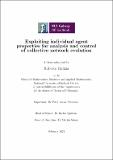| dc.description.abstract | In this thesis, we investigate linearly coupled dynamic networks made up of identical oscillators. We study the principles in which the dynamical features of the underlying constituent agents transfer to the collective dynamics of the entire network. This is carried out from two points of view: analysis and control.
In the former case, the objective is to predict the dynamical behaviour of the entire network, by studying the structural properties and the asymptotic dynamical behaviour of the uncoupled agents. However, due to the high complexity that arises when many agents are connected with each other, it is not always possible to determine all the asymptotic solutions of a network. Therefore, we focus on analysing under what conditions we can guarantee a 1-to-1 correspondence between the limit sets of the uncoupled agents and the network. In other words, we investigate the scenario where all network agents behave like a single uncoupled agent. This behaviour, which we refer to as reduced dynamics, extends the subject of network synchronization to a global scale. In some cases, we are able to prove analytically that a region of reduced dynamics exists if the network parameters satisfy certain conditions. In the more general case, we conjecture the conditions for existence of this region and support the conjecture with numerical experimental evidence.
In the latter case, we define a control strategy to obtain a desired global dynamical behaviour while only acting on a small subset of the network nodes, without using any global information. In other words, we design a decentralised control algorithm that drives the entire network towards a desired state, based only on local information of a small subset of nodes and their neighbours.
In order to validate the control algorithm we test it via simulations for networks with different properties and topologies. First, these numerical experiments are conducted on networks of bistable agents with vector field given by a cubic function. We compare the decentralised strategy with three centralised algorithms in order to evaluate its performance. Finally, we extend our experiments to a network of agents where the uncoupled dynamics presents a discontinuity. In particular, we consider the model of a ball or a particle impacting on an oscillating floor. The strong nonlinearity introduced by impacts makes the network dynamics very unpredictable and we show some numerical examples of the complexity that can arise in such systems. Despite the complexity, we also show that with a proper control action we can use the decentralised control algorithm to control the network and thus synchronizing all the agents. | en_IE |


